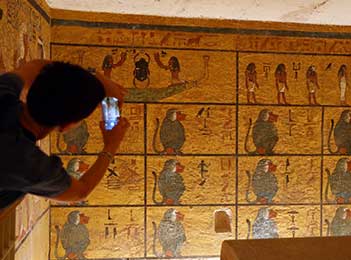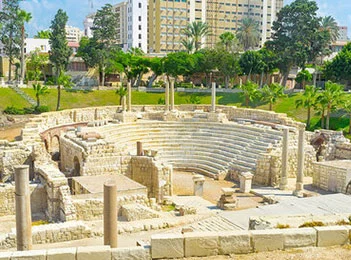 The original core of this huge Karnak building dates back to the Middle Kingdom in the ruling period of Senusert I in the 19th century BC when he constructed the first shrine for the statue of Amun to be a religious building.
The original core of this huge Karnak building dates back to the Middle Kingdom in the ruling period of Senusert I in the 19th century BC when he constructed the first shrine for the statue of Amun to be a religious building.
Afterward, in the 15th century BC, Amenophis I built a new kingdom, the Middle Kingdom Court of the first bark chapel of Amun. Then his son, Tuthmosis I who ruled Egypt at the end of the 15th century BC was the one to be responsible for the enlargement of the Karnak building that was carried out from East to West.
Tuthmosis I and his son Tuthmosis II were credited for building the pylons VI and V. They also constructed the famous papyrus columns that were used for coronation ceremonies. Tuthmosis I also built the very first two Obelisks of this great temple but only one of them survived until today.
The famous Queen Hatshepsut with her amazing mortuary Temple in the West Bank of Luxor constructed a new chapel for the sacred barks that were erected in the new Kingdom Court that was called the red chapel due to the color of its stones.
Hatshepsut has built two high obelisks as well which were taller than these of Tuthmosis I; one of them is still standing while only the top of the second one is now situated near the sacred lake of the Karnak building.
The famous queen was also responsible for an important landmark in the history of the great temple of Karnak as she built the pylon VIII that gave the temple another north to south axis.
During the ruling period of Thutmose iii, who was called the Napoleon of ancient Egypt due to his large military campaigns, the temple was enlarged again. He also erected two obelisks. However, none of them existed until today.
Thutmose iii has also built a unique monumental temple complex in the Eastern section of the Middle Kingdom Court and what was called the botanical garden as well. This section held that name because of the bas-reliefs that all over its walls with plants and flowers.
In the Southern section of the Temple of Karnak, there is the sacred lake that had two functions; a practical and a symbolic function. The sacred lake was used for ablutions for rituals and for the needs of the priests who used to live nearby.
In the 7th century BC, during the reign of King Taharqa, he constructed a sanctuary that was used to celebrate the creation of the world by the god Amun in Amun Ra temple. This was why the scarab statue, which was originally in the section constructed by Amenophis III was brought near the sacred lake.
This great temple is surely the most impressive ancient Egyptian monument and the largest religious building. Being constructed over a period of more than 2000 years, it amazes all the travelers who tour Egypt and visits the Temple. Archaeological missions are still working until today in the Temple and they unearth interesting findings every now and then.



 Karnak Temple ComplexThe Temple is located in
Karnak Temple ComplexThe Temple is located in  To answer the question, Who built the temple of Karnak you have to know the history of the Karnak
To answer the question, Who built the temple of Karnak you have to know the history of the Karnak  The hypostyle hall in Egypt was first established during the ruling period of Sethos I in the 14th century BC,
The hypostyle hall in Egypt was first established during the ruling period of Sethos I in the 14th century BC,  The original core of this huge Karnak building dates back to the Middle Kingdom in the ruling period of Senusert I in the 19th century BC when he constructed the first shrine for the statue of Amun to be a religious building.
The original core of this huge Karnak building dates back to the Middle Kingdom in the ruling period of Senusert I in the 19th century BC when he constructed the first shrine for the statue of Amun to be a religious building.




